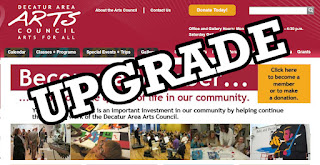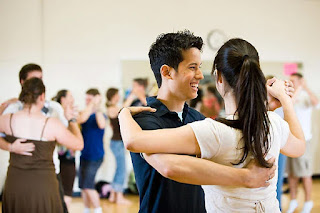It’s a common misconception among the non-dancing population
that one takes a class and learns to dance. Dive into the understanding of just
how powerful dancing can be in your life! Read on!
All across the USA, locally owned small business dance
studios provide classes, lessons and workshops teaching kids and adults how to
dance in a wonderful plethora of gorgeous dance genres and styles! Wherever you
might live and work, it’s guaranteed that you have a neighborhood dance studio
not far from your children’s school, or your usual route to shops, parks, and
downtown centers. Families with little girls, adults seeking low-impact
exercise, and people of all ages looking for a new active social opportunity,
they all gravitate to where they can find a local beginner-level entry point
into the world of dance.
At your neighborhood dance studio, the dance instructors
know deeply that while the brand new people coming through the door think
they’re coming in just to learn how to dance, the deeper reality is that dance
instructors lead people on a journey of self-discovery and transformation where
as you learn how to dance, you’re also getting deeply in touch with your own
body in ways that you’ve never before been directly led to do. Coordination
deepens. Awareness of unknown muscle groups, sinews and tendons develops. Attunement
to your body and it’s needs rises. Physical musicality grows.
If you’ve ever spent time taking your child to dance lessons, you’ve probably
perceived the differences between yourself and the other parents compared to
the dance teacher instructing the class, but you might not have had words to
put to that subconscious recognition. There are parents, and then there is the
Dancer.
Doctors and medical professionals recommend dancing as a low-impact exercise
good for all ages. Regardless of the genre of dancing you choose to pursue,
getting into dance as an activity is incredibly good fitness, great fun, and it
also challenges the mind in ways that are proven to combat the mental decline and
degeneration that comes with the human ageing process.
The more subtle processes, the transformation that happens
as people become dancers, is often imperceptible to the new
dancer until they experience a lightbulb moment.
·
Kids in Ballet or Hip Hop or Jazz develop
coordination that leads to fewer broken bones throughout childhood, and their
minds are challenged in dance in ways that transfer over to make them perform
better in school, so their grades improve and parents and teachers take notice!
·
Adults who join a dance class notice when they
drop a few pesky unwanted pounds. They also notice when their everyday mood is
elevated, they sleep more deeply, and their work projects somehow seem easier and
come together more effortlessly because they’ve activated their mind through
dance and improved their cognitive performance.
·
Couples who start dancing together often notice
a renewal, a deepening of their relationship in a new and different way than
they’ve ever experienced before. The partners see one another in a new light,
with new connection, with a different feeling. Partnered dancing could expose
stale issues to the light or lift a couple into a new and closer way of being.
As people learn to dance, it seeps out into every corner of
your life and suffuses your being with a new WAY of being. Bodies that
previously suffered and ached from neglect and lack of care become valuable and
powerful vessels to contain your new conscious ownership and care of your physical
form. Dancers learn to love their bodies as they learn steps and moves. Dancers
develop necessary habits and practices of self-care to keep their bodies, their
joints, their muscles, and their feet, fit and ready to dance and move.
Learning to dance is far more than just learning some steps.
Somewhere in the new dancers’ process of lessons or classes,
they’ll prick up their ears to some music playing and possibly realize
consciously that through their dance class, they’ve learned how to pick the
beat and rhythm out of the music they hear, and now suddenly they’re hearing it
everywhere! Via learning dance, they’re also learning musicality.
Sometime in a couple’s progress through a class together,
they may realize they suddenly have something new to talk about, laugh about,
and connect about, rather than the same old stale daily grind conversations
about work, kids, bills and the same-old thing. This new thing is theirs,
together, something they do, but also a new container, a new place and stage
for their relationship.
Adults who start dancing soon find themselves surrounded
with a wholly new grouping of friends, acquaintances, dance partners and social
activities that gets them out of the house and DOING in ways that shines a
light on their previous isolation, and they realize how just-not-good-enough
that previous way of life really was.
Learning to dance is a metamorphosis process – People become Dancers!
If you’ve ever met a dancer, you know the way they move
through life is just… different. The way they walk, their posture, the
way they hold themselves and carry themselves, you can SEE that they must be a
dancer. It shows in every aspect of their being and you notice their tuned-in
ownership and control of their physical body, their attunement to the sounds
and music around them, their ability to engage and connect with you somehow
more deeply, and less superficially, than everyone else that you know. You can
perceive that they somehow think and function differently. Dancers walk through
life… like dancers.
The process of getting from Average Joe to Dancer, the gradual
transformation you can experience, these subtle shifts happen imperceptibly
within you at first when you’ve only had just a class or two. But just give it
time. Your own process of becoming a dancer happens at your own unique pace.
Dance instructors can watch in any given class and see the different pace of
acclimation from one person to the next, seeing some people take to it easily
and eagerly with wide open eyes and minds, while some others demonstrate fear
and apprehension about every new step.
If you can look at the process of learning dance, not just
as learning dance, but as a whole-being transformation journey taking you from
where, and who you are right now, into a new existence as a dancer who is tuned
in and empowered in your physical being and ignited in your active living mind
and spirit. You have the power to engage in owning your process and your
transformation with ease and grace.






